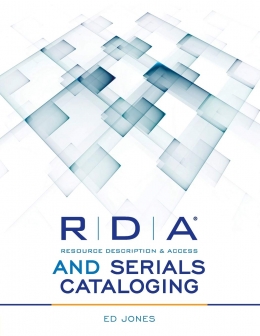
RDA and Serials Cataloging
For UK or EU purchases, contact Facet Publishing to order. For all other purchases outside the United States, please consult our International Orders page.
Primary tabs
You don't need to be an ALA Member to purchase from the ALA Store, but you'll be asked to create an online account/profile during checkout to proceed. This Web Account is for both Members and non-Members. Note that your ALA Member discount will be applied at the final step of the checkout process.
If you are Tax-Exempt, please verify that your account is currently set up as exempt before placing your order, as our new fulfillment center will need current documentation. Learn how to verify here.
- Description
- Table of Contents
- About the author
- Reviews
Serials and continuing resources present a variety of unique challenges in bibliographic management, from special issues and unnumbered supplements to recording the changes that a long-running periodical can experience over time. Easing catalogers through the RDA: Resource Description and Access transition by showing the continuity with past practice, serials cataloging expert Jones frames the practice within the structure of the FRBR and FRAD conceptual models on which RDA is based. With serials' special considerations in mind, he
- Explains the familiarities and differences between AACR2 and RDA
- Demonstrates how serials catalogers' work fits in the cooperative context of OCLC, CONSER and NACO
- Presents examples of how RDA records can ultimately engage with the Semantic Web
Occasional serials catalogers and specialists alike will find useful advice here as they explore the structure of the new cataloging framework.
Introduction Part I Preparation Chapter 1An Introduction to Serials and Serials Cataloging Chapter 2 Getting to Know RDA: A New Structure and Other Changes from AACR2 Part II Serials Cataloging Using RDA Chapter 3 Searching and the Universe of Serials Chapter 4 Cataloging Serials and Ongoing Integrating Resources Using RDA
1. General Instructions Relating to Serials Cataloging Using RDA and MARC 212. Attributes of Resources (Manifestations and Items and the Works and Expressions They Embody (by ISBD Area)3. Relationships between Resources4. Identifying Works and Expressions [RDA 6]5. Identifying Related Entities (Authorized Access Points for Persons, Corporate Bodies, and Other Resources Related to the Resource Being Described)6. Online Serials and CONSER Provider-Neutral Records7. Ongoing Integrating Resources
Epilogue RDA and Linked Data
Ed Jones
Ed Jones (MLS, Kent State University; PhD, University of Illinois at Urbana-Champaign) has been active in serials cataloging during the whole of his professional career. Over this time, he has represented various institutions on the CONSER Operations Committee and has served on many CONSER and Program for Cooperative Cataloging (PCC) committees and task groups, including as CONSER representative to the PCC Policy Committee and cochair of the PCC Standing Committee on Standards (SCS). He is currently cochair of the SCS Task Group on CONSER Policies for Official RDA in MARC. He has spoken extensively on RDA and its underlying conceptual models over the years, serving as an RDA advisor for the Original RDA Toolkit and more recently chairing the Serials Task Force of the RSC Aggregates Working Group during the RDA Toolkit Restructure and Redesign (3R) Project. In 2019, in recognition of his professional contributions, he received the Ulrich’s Serials Librarianship Award from the Association for Library Collections and Technical Services (ALCTS).
"A refreshing lack of tentativeness makes this a usable manual for hands-on practitioners. There is no ‘hemming and hawing' over matters where RDA is still a moving target and continuing to develop … Working catalogers will be able to use this manual for day-to-day practice and will find it of lasting value as a reference manual for unusual or difficult cases. It will be found useful in libraries large and small and can serve as a reassuring introduction to the cataloging of serial publications. Deft deployment of wry humor makes the book pleasantly readable."
— Collection Building
"Highly recommended for any situation – technical service departments or library students – where serials need to be catalogued using RDA protocols."
— Australian Library Journal


